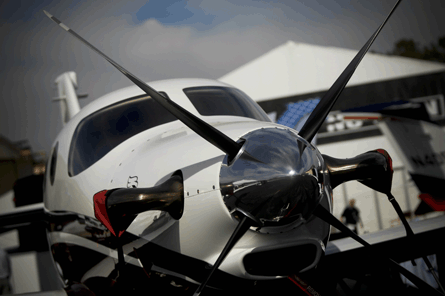Kestrel Aircraft has brought in a test pilot to perform handling and wing laminar flow testing of its F1 proof-of-concept prototype, in advance of the first flight of the Maine-based company's new aerodynamically conforming prototype in 2012.
Included in the testing for the flight campaign, which company official Adrian Norris characterised as "not intensive", are the effects of leading edge pneumatic de-icing boot systems on the natural laminar flow (NLF) characteristics of the Kestrel's wing.
Norris said the wing - as designed by Kestrel predecessor Farnborough Aircraft - has NLF over more than 60% of its chord, a design feature verified in part by wind tunnel testing. Coming up with a de-icing or anti-icing system is a challenge, however.
 |
|---|
© Billypix |
Norris said a pumped anti-icing system using glycol-based fluid - known as TKS - is "not a good option" for Kestrel, as it adds weight and pilots have to anticipate icing conditions.
Alan Klapmeier, chief executive of Kestrel Aircraft and former chief executive of Cirrus Aircraft, had selected TKS for anti-icing on the Cirrus single-engine fleet. "With boots, there's no need to top off on TKS [fluid]," Norris added.
Pneumatic boots, however, could cause a problem with the aerodynamic efficiencies gained by NLF for the wing. "We will use boots but we're working on how to do that and not trip the boundary layer," said Norris. A portion of the flight test work is dedicated to that issue.
The original wing featured a 13m (43ft) span, elliptical leading edge and three-segment front and rear spars.
On the aerodynamically conforming prototype the wing will have a 14m span, the leading edge will have less curve and the rear spar will be straightened to simplify construction. Norris added that the fuselage design, which features a larger cabin, cockpit and baggage compartment, is already complete and the company is aiming to "freeze all important design decisions" for the aircraft within the next month, to allow the new prototype build to begin.
In July, Kestrel announced that the aircraft would be powered by a Honeywell TPE331 turboshaft engine rather than the Pratt & Whitney Canada PT6A-67A used on the proof-of-concept aircraft. The company has not yet selected its avionics provider.
Over the next year, Norris said Kestrel plans to build tooling for the aerodynamically conforming prototype and fly the aircraft before the end of 2012. The company has approximately 50 engineers working on the programme - 25 at a facility in Minnesota and 25 on location at its factory at the former naval air station in Brunswick, Maine - the anticipated production facility for the aircraft, depending on the receipt of state aid.
Company officials said economic development funding from Maine has been slow to materialise, although Kestrel remains confident the incentives "will fall into place".
Source: Flight International























